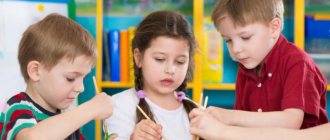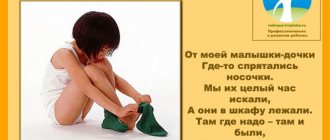Canteen duty
This routine moment in the middle group instills in children a responsible attitude towards the assigned task and a desire to take care of their friends. Those on duty wear aprons and chef's hats, which creates additional motivation. Each child sets his own table. The number of responsibilities increases significantly compared to the younger group. The attendants learn how to serve correctly, lay out cutlery, including knives, arrange bread bins, cups, saucers, and fill vases with napkins. Their actions are supervised by an assistant teacher.
After lunch, the children clean up the bread bins, napkin holders and stacked plates, carefully sweep away the crumbs, and together they roll up the tablecloth. The teacher constantly emphasizes the importance of such work. The rest of the children, having had lunch, thank not only the cook, but also the people on duty. With the right approach, preschoolers are happy to do this kind of work and by the end of the year they can cope with it without the help of adults.
Educational activities in the middle group
Regular moments include special classes in mathematics, music, physical education, speech development, drawing, etc.
The following points are taken into account:
- Children of the fifth year of life are able to perceive new information for no more than 20 minutes.
- There are 2 classes before lunch. A couple of times a week after afternoon tea, you can organize another lesson (physical education, theater group, musical games).
- Mathematics, as well as speech development, are subjects that involve a high load on the baby’s intelligence. They cannot be combined on the same day.
- It is better to put mathematics in the middle of the week so as not to overload preschoolers on Monday and Friday.
- Children should learn by playing. If the lesson takes place at a table, there must be an entertaining physical education session in the middle. Between two lessons, young students are allowed to run for 10 minutes.
Morning reception
According to the schedule of routine moments, in the middle group the day begins with the children arriving at kindergarten. The teacher’s task is to greet them joyfully and include them in interesting games with friends. Some kids have a hard time letting go of their parents. They need to be distracted: act out a scene with toys, show them a blooming flower, offer to take care of the plants.
A good tradition would be to hold a morning circle. It includes the following elements:
Walk
In the cold season, 4 hours are allocated for this routine moment in the middle group. In summer, children walk all day, entering the group only to eat or sleep. To keep the kids occupied, the following tools are brought outside:
- items for cleaning the site (buckets, brooms, shovels, dustpans);
- toys (balls, sandbox sets, children's shovels, skittles, jump ropes);
- animal masks or hats necessary for organizing outdoor games.
Traditionally, during a walk, children:
The teacher leaves time for children to engage in independent activities. During it, individual work is carried out with individual students.
Basic principles of organizing the daily routine
Definition 1
Daily routine is a measured order of actions planned for the day.
While the child is in kindergarten, his life activities correspond to a regulated routine. The alternation of educational activities and outdoor games, rest and active wakefulness helps to avoid nervous fatigue in children.
Depending on their age, children are engaged in mastering certain self-service skills and learning to communicate culturally. It is important that in kindergarten the child not only develops, but also satisfies his need for active movements, nutrition, timely rest, etc.
Planning of routine moments in the middle group is based on studies of the physiology of children. Taking into account the age characteristics of the pupils. The basis of the regime are the following principles:
Are you an expert in this subject area? We invite you to become the author of the Directory Working Conditions
- rhythmicity - changing types of activities in accordance with internal cycles characteristic of children 4-5 years old;
- cyclicality – a constant schedule forms a habit and relieves nervous tension;
- alternation of rest and active pastime - throughout the day, outdoor games replace quiet activities, educational activities are replaced by artistic activities, and wakefulness is replaced by sleep;
- flexibility - when the child is tired, he should be able to retire. If he wakes up too early, he engages in quiet games with books and toys;
- gradualism - preschoolers should not be rushed, they should be given the opportunity to independently complete the work they have started;
- individual approach – some children may need additional help and special attention. The teacher must gradually include them in the general rhythm.
Consultation for teachers “Organization of regime moments in preschool educational institutions. Preparation for sleep"
Natalya Dolmatova
Consultation for teachers “Organization of regime moments in preschool educational institutions. Preparation for sleep"
Municipal budgetary preschool educational institution "Kindergarten No. 15" of the city of Aleysk, Altai Territory
Consultation for teachers
Topic: Organization of routine moments in preschool educational institutions “Preparing for sleep and awakening gymnastics”
Completed by: N. V. Dolmatova
Organization of routine moments in the preschool educational institution “Preparing for sleep and awakening gymnastics”
Goal: To develop discipline in preschool children. Creating a calm environment and a positive mood before bed. Develop independence when undressing, accuracy when folding clothes. Cultivate kindness and respect for peers.
The period of preparation for bed should be calm and balanced. Children are not recommended to be distracted by noisy games or emotional conversations. When undressing, the teacher makes sure that the child frees his hair from bows, hairpins, etc.
Daytime sleep is one of the most important factors in the harmonious development of a child and helps to spend the rest of the day in a good mood.
The teacher promotes a calm and relaxing environment in the bedroom and a positive attitude towards daytime sleep. It is necessary to check whether the children are comfortable in their beds, or even better, approach each one, straighten the blanket, pat them on the head and wish them a restful sleep. It is best for a child to sleep on the right side with the body in an arched position. This is a natural, physiologically optimal position. Be sure to observe the child's breathing - it should be nasal. During the ritual of getting ready for bed, a calm melody or lullaby can be played in the group, setting the children up for rest. The teacher can tell them a familiar and beloved fairy tale in a quiet, calm voice. You can sing a lullaby. You should not ask children questions at this time, tell action-packed stories, or call children by name. The child falls asleep - this is a fragile phase of sleep, and it must be protected. Otherwise, the child will be artificially perked up, and then it will be very difficult for him to fall asleep.
The eyelashes droop and the eyes close. We rest peacefully, fall asleep in a magical sleep
Background music is playing, children are lying on rugs and listening to the fairy tale “Cinderella” by Charles Perrault
Carrying out the regime moment “Rising”
Goal: ensuring a smooth transition from sleep to wakefulness, a positive emotional mood, preparation for vigorous activity.
- Good afternoon! Wake up quickly! Smile wider at the sun!
With these words the teacher greets the waking children. Complexes based on a game plot and including elements of improvisation allow one to achieve maximum motor and emotional activity. The teacher accompanies the demonstration of exercises with an explanation. The number of repetitions of each movement depends on the desire and physical condition of the children. The complex is carried out within 5-7 minutes. Children do not wake up from naps all at once. And we try to ensure a smooth gradual recovery of each child from sleep. To do this, the teacher turns on quiet, calm music a few minutes before getting up. Gradually, as the children wake up, the volume of sounds increases. After the children wake up, awakening gymnastics are performed. This is a specially designed set of exercises that allows you to gradually warm up the muscles and lift the mood of children.
I. Introductory part Quiet music is turned on, to which the children gradually wake up, and gymnastics are performed.
We all woke up together, smiled, stretched (Movements corresponding to the text) Breathed deftly (Breathe through the nose) Hummed loudly (oo-oo-oo-oo) Raise your shoulders like grasshoppers in the grass. (Energetic movements of the shoulders up and down). The bear crawled out of the den and looked around at the threshold. (Lying in bed, throw the blanket to the side, turn his head to the right, left) He stretched from sleep Spring has come to us again (Hands up, stretched) To quickly gain strength, He twisted his legs (Movement “bicycle”) The bear scratched behind his ear, ( They imitate the movement of a bear) He wagged his tail slightly, (According to the text) He leaned back and forth, (Bends from a lying position) And with his legs he barely goes beyond the threshold. (Get out of bed) A bear is walking through the forest. This bear is looking for honey. (Walking in place with turning his head to the right, left) He is hungry, sad, Conversing with spring: (They walk out of the bedroom with a bearish step and growl) “Tell me, spring, Where can I get more honey? (Children move to the massage paths (prevention of flat feet): I see stumps, roots, There is no honey, no grass." (They walk, bend over, look in, “looking for honey”) The bear waved his arms, As if dispersing clouds. He drives them back and forth, Well , but he won’t find any honey. (Rotate with straight arms back and forth) He squatted lower, deeper, Found a swarm of bees (Squatted, stood up) But the bee family drove the bear away. Breathing exercises:




